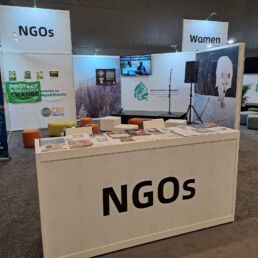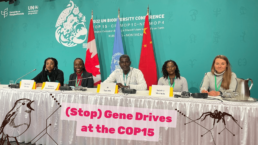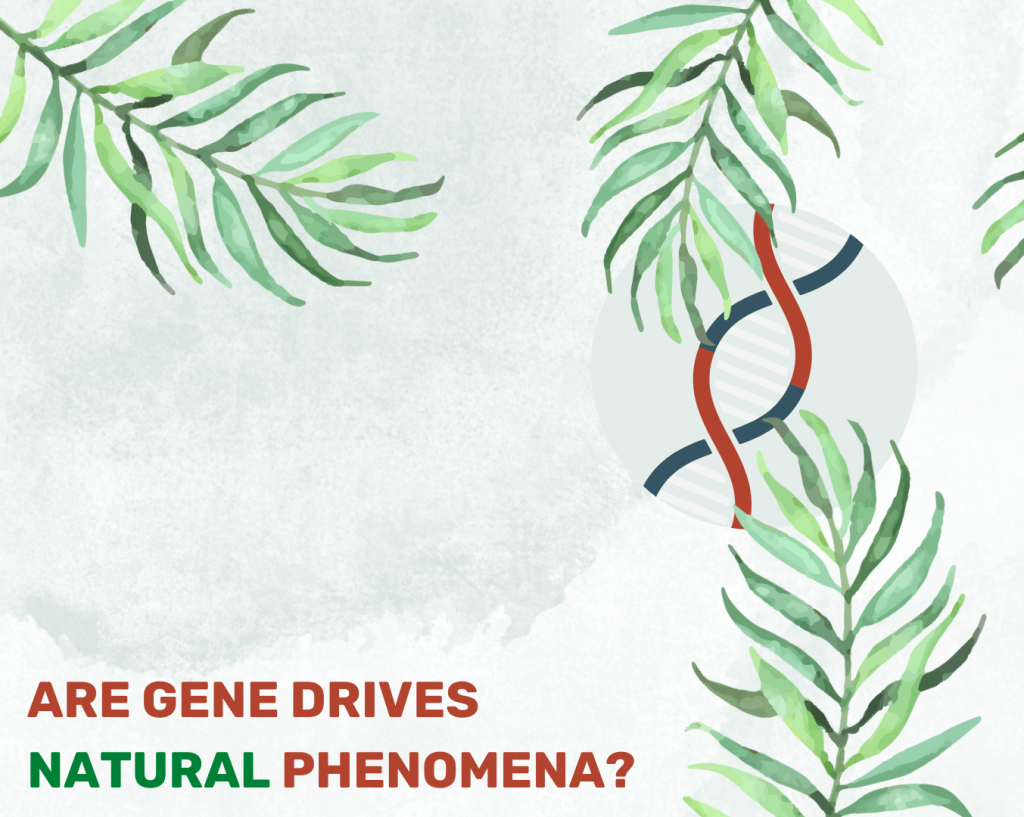Homepage
The CBD as a vehicle to promote biotechnology?
Fresh from COP16, our campaigner reports on the push to shift the CBD’s focus from regulating gene drives and other biotechnologies to promoting them—putting biodiversity at risk. Read the full article as published in today’s ECO:
As biotechnology reaches ever greater capabilities to “re-design” nature, some want to turn the CBD into a place for the promotion rather than regulation of biotechnology. Parties to the Convention cannot let this happen, warns German-based NGO Save Our Seeds.
When the CBD was first written, biotechnology was – rightly – seen as a threat to biodiversity and its sustainable use. The Convention’s text focusses on the risks arising from the use and release of genetically engi-neered organisms, although it also talks about sharing the “results and benefits arising from biotechnologies” when they are based on genetic resources from deve-loping countries.
Fast forward to 2024 and the situation is very different. In the CBD context, there is more and more language about the potential benefits of biotechnology, to the detriment of the precautionary approach enshrined in the Convention.
This comes at a time when biotechnology is becoming ever more powerful. Organisms are no longer just “genetically modified” but increasingly “new-to-nature”. The CBD uses the term “synthetic biology” for the “further development and new dimension of modern biotechnology” based on tools such as DNA synthesis, next-generation sequencing, bioinformatics, and genome editing.
Synthetic biology tools have long been used to engineer microbes producing pharmaceuticals or food ingredients in contained facilities. However, more recent applications are also for use in open environments, such as microbes engineered to support the uptake of fertilizer in crops.
A multidisciplinary expert group (mAHTEG) of the CBD has looked into aspects such as the “integration of artificial intelligence and machine learning”, “self-spreading vaccines for wildlife” and “engineered gene drives to control vector-borne diseases and invasive species” (Document CBD/SYNBIO/AHTEG/2024/1/3). The expert group was meant to look into the future and inform CBD Parties about things to come. But the future is already here. Artificial intelligence is being rapidly taken up for engineering microbes and proteins, and “self-limiting” insects have already been released in places like Brazil and the US. The experimental release of gene drive mosquitoes, originally planned for 2024, is still being pursued in Uganda and other African countries.
Such extreme forms of genetic engineering represent a whole new dimension of environmental risk. Gene drives, for one, are intended to alter or exterminate whole populations of wild species, resulting in potentially irreversible harm even beyond the country of release. The precautionary principle, enshrined in the CBD more than 30 years ago, has never been more precious and indispensable for the protection of nature and people.
But a handful of Parties such as Brazil and the UK, are intent on blocking any in-depth assessment of the issues considered by the expert group. Instead, they say the CBD should look into potential positive impacts and benefits that synthetic biology can deliver for the achievement of the KMGBF.
Biotechnology interests are also at work in other CBD workstreams. A draft paper on plant conservation (CRP 1) proposes to “support research and development … to enhance the benefits arising from the use of safe biotechnologies”. Another draft on biodiversity and health (CRP 6) wants to “promote the sharing of benefits for health arising from biotechnological developments”.
Luckily, not all Parties are blind to the potential problems arising from genetic engineering and a proposed non-paper on synthetic biology remains highly controversial. Let’s hope that reason prevails, and the CBD will not only continue to caution against negative outcomes but manage to effectively regulate these powerful technologies.
COP16 – what is at stake for gene drives?
Parties to the “Rio” Convention on Biological Diversity (CBD) and the Cartagena Protocol are meeting in Cali, Colombia, between October 21 to November 1, 2024. What is at stake for gene drives in the coming days?
Gene drives are on the agenda under two key items, under “Synthetic Biology” within the CBD’s Conference of the Parties (COP), and under "Risk Assessment and Risk Management" within the Cartagena Protocol’s Meeting of the Parties (MOP).
Two crucial reports are up for discussion—one from a multidisciplinary Ad Hoc Technical Expert Group (mAHTEG) on Synthetic Biology including horizon scanning, technology assessment, and monitoring, and another one from a (not so multidisciplinary) Ad Hoc Technical Expert Group (AHTEG) outlining risk assessment guidelines for gene drive organisms.
Report on Synthetic Biology
At COP15 in 2022, a multidisciplinary group was tasked with conducting horizon scanning on emerging technologies that could impact biodiversity. The group presented initial findings on five issues including gene drives, and Parties proposed during a preparatory meeting to COP16 that the mAHTEG should conduct an in-depth assessment of several issues including “potential impacts of engineered gene drives to control vector-borne diseases and invasive species”.
However, gene drive developers are pushing back against any specific consideration of gene drives and several countries, such as Brazil, Argentina, Canada and New Zealand (see previous ECO article about this group) are lobbying to stop any further work by the mAHTEG. Instead, they are proposing an "action plan on synthetic biology," which could pave the way for the global development and transfer of gene drive technologies. The Stop Gene Drives campaign is actively pushing to ensure that gene drives undergo a thorough assessment.
Gene Drive Risk Assessment Guidance
Parties to the Cartagena Protocol are likely to “welcome” the guidance materials for the risk assessment of living modified organisms containing engineered gene drives developed by an Ad Hoc Technical Expert Group earlier this year. This is despite the fact that the Guidance is not sufficiently precautionary, according to scientists from the European Network of Scientists for Social and Environmental Responsibility (ENSSER). It shifts the burden of proof from having to prove safety to having to prove harm and uses a “problem formulation approach” that is not fit for purpose. This approach was introduced by Mr. John Connolly, the Senior Regulatory Science Officer for Target Malaria, an organisation aiming to release gene drive mosquitoes in Africa.
Initially, many Parties including the EU, UK and others wanted to go further and ”endorse“ the guidance. But in a late-night session on the third day of the COP-MOP, Parties went with the less strong wording “welcome”. However, the Guidance will not be subject to a wider independent review, as our NGO coalition had asked for. It remains to be seen whether and how it will be used in the context of planned releases of gene drives.
Read our detailed brief for more insights here.
SBSTTA 26: Urgent need for international biosafety oversight and the right to say no, as gene drive mosquito projects expand in Africa
As participants in the 26th Subsidiary Body on Scientific, Technical, and Technological Advice (SBSTTA 26) of the UN Convention on Biological Diversity (CBD), we will be sharing insights through articles authored by members of the CBD-Alliance’s Working Group on Synthetic Biology, to which we belong.
Key topics of discussion at the Nairobi conference include synthetic biology and the risk assessment of gene drives. For more detailed information on the issues at play, we invite you to consult the briefings (short/long) we have developed in preparation for this conference.
Please find below an article by our partner Sabrina Masinjila from the African Centre for Biodiversity:
Urgent need for international biosafety oversight and the right to say no, as gene drive
mosquito projects expand in Africa
Gene drives, a form of synthetic biology, pose significant risks with their potential to alter entire species, including driving them to extinction. Discussions on gene drives under the Convention of Biological Diversity (CBD) have been extremely contentious, as those with vested interests have been blocking international biosafety regulation and oversight.
Projects like Target Malaria and Transmission Zero (T0) are advancing the deployment of gene-drive mosquitoes, primarily targeting malaria-carrying Anopheles mosquitoes, in both West and East African countries. However, these initiatives have proceeded in the absence of internationally agreed biosafety standards to govern risk assessment and management during the contained use experimental phase as well as open releases.
This is compounded by scant biosafety institutional and regulatory capacity in Africa, a lack of regulatory experience, and no transparency in terms of information, as required by the Cartagena Protocol on Biosafety and national biosafety regulations.
African civil society in Tanzania, for example, where the T0 project operates, have raised concerns about limited wider public consultation and access to pertinent documents.
While malaria is a huge public health challenge in Africa, investments should focus on systemic solutions that provide adequate healthcare, clean water, and sanitation.
Please see ACB’s new blog for more detail: https://acbio.org.za/gm-biosafety/expansion-of-gene-drive-mosquito-projects-in-africa/
Gene drive organisms pose unacceptable risks to biodiversity and human health and the draft guidance for risk assessment developed under the CBD to date is not comprehensive enough to address the uncertainties. Further guidance that invokes the precautionary principle and the right to say no is essential. We strongly urge African governments to support further guidance under the CBD that provides thorough methodologies capable of fully addressing the risks.
World Malaria Day 2023 and the gene drives deception
World Malaria Day 2023 and the gene drives deception
At the occasion of World Malaria Day (25 April), the Stop Gene Drives Campaign encourages you to take a closer look at the insights and perspectives shared by prominent actors and other organisations closely monitoring the subject on this significant day.
By 2030, the World Health Organization (WHO) hopes to reduce the global malaria burden by ninety percent (in comparison to a 2015 baseline). Running against the clock, facing unforeseen obstacles, and with multiple interests on the table, recent years have seen setbacks in the progress of malaria control.
Particularly during the Covid-19 pandemic, health service disruptions, diverted resources, and reduced access to affected communities posed concrete obstacles towards the 2030 target.
Aiming at overcoming such obstacles and accelerating the process, the 2023 World Malaria Day was marked by the theme “Time to deliver zero malaria: invest, innovate, implement”. On social media and online, this slogan was well exploited to reinforce a narrative in which biotechnology (particularly gene drives) is the pinnacle of innovation in malaria control.
We invite you to look at a few examples and join us in uncovering the stories behind them.
A new type of celebrity
Target Malaria, a controversial research consortium backed by US military funding from DARPA, took the opportunity to reinforce its narrative of innovation equals solution.
In their story, scientists are the equivalent of rockstars, who will use their latest creations to save the world from malaria. They insist that urgent innovation (i.e. new genetic technologies, particularly gene drives to eradicate mosquitos) is the only viable remedy in the face of the critical situation. This scenario, in their view, seems to exist is a vacuum where risks are minimal and negative consequences are not taken into account. Other organisations followed a similar recipe of presenting ‘science and innovation’ as the (only) tools that can put malaria control back on track. (See examples here, here and here)
This tunnel-vision narrative is dangerous and deceptive. In addition to spreading misinformation, efforts that are led by pressure to produce immediate results and return on investment, can easily overlook risks, produce flawed results, and only address issues at surface level. In addition to that, it creates momentum towards a false idea that a final solution to the malaria burden has been found – which is unfortunately still not a reality.
A deep wound cannot be treated with a bandage
Fighting malaria is a complex issue that requires structural and long-term solutions. The push for the deployment of technologies (such as gene drives) ignores both ecological risks and context-related challenges.
At the occasion of World Malaria Day 2023, several organisations and actors raised concerns about why it is crucial to go beyond the superficial, quick-fix/technical aspect of fighting malaria.
The most recurrent concerns highlighted the need to also fight socio-economic and infrastructural factors that enable the prevalence of malaria. These include poverty, gender and other inequalities, inadequate water, sanitation, and hygiene infrastructure, and lack of access to education and healthcare.
Some argue that every malaria case is preventable and avoidable, urging global leaders to increase funding and action. They promote different tools such as enhanced bed nets, vaccines, monoclonal antibodies, and mosquito sugar baits. Advocating for a holistic approach that provides communities with necessary tools and addresses underlying causes. (See examples here, here, and here)
What else is there to uncover?
There seems to be a consensus among those engaged in eradicating malaria that progress towards a dramatic reduction by 2030 is delayed. In this context, narratives that advocate for rushed ‘innovation’ and new technologies as the solution tend to overlook risks and potential irreversible ripple effects.
The emergency of new challenges, such as the detection of a new malaria vector in Sub-Saharan Africa, highlights the importance of carefully considering whether technofixes can soon become obsolete. This is in addition to being sensitive to the myriad of cascading effects that the deployment of an unpredictable and irreversible technology could have in ecosystems and human health.
Research aimed at malaria eradication should be conducted with caution and responsibility as well as be based on serious and accurate scientific methods and findings. Furthermore, it should explore multiple solutions and alternatives (e.g., nets, antimalarial drugs, vaccine, etc.) and not exist in isolation from its context. All efforts to reduce the malaria burden need to consider and address the underlying socio-economic and infrastructural factors that contribute to its prevalence.
Finally, breaking down the narratives and stories being communicated on the topic can be helpful to uncover hidden agendas and identify oversights in the evaluation of tools and methods to eradicate malaria. Hopefully, contributing to a more adequate and informed evaluation of options and balanced and responsible decision-making in fighting malaria.
Further resources:
Learn more here about the applications and risks of gene drives in the context of malaria eradication.
Access here the African Center for Biodiversity’s analysis on the linkages between capitalism and malaria.
Watch here an interview with Burkinabé activists Ali Tapsoba and Guy Yameogo assessing community engagement for gene drive release in their country.
Access here some insights from front line workers on the issue of gene drives and malaria.
What happened to Gene Drives at COP15 of the UN Convention on Biodiversity?
What happened to Gene Drives at COP15 of the UN Convention on Biodiversity?
In December 2022, States from all around the world gathered in snowy Montreal to discuss the future of biodiversity protection and conservation until 2030. What did they have to say about new technologies such as gene drives?
The Post-2020 Biodiversity Framework (GBF) has been often referred as a ‘breakthrough’ to halt biodiversity loss. However, the discussions and decisions made in Montreal left synthetic biology watchdogs, like the Stop Gene Drives Campaign, with a bitter aftertaste of corporate influence.
Biotechnology giants such as Brazil and Argentina strongly negotiated to remove any mentions to the precautionary principle and risk assessment from all texts. There was also persistence in inserting the dogma of ‘innovation’ wherever possible. After five Open Ended Working Groups over the course of three years and two weeks of COP15 discussions, the world is left with a Target 17 on Biotechnology that does not do anything beyond reiterating the CBD Convention of 1992. One clear sign that the world of biotechnology has evolved since 1992 is that some of the negotiators sitting at the table today were born in that year. Unfortunately, the new Post-2020 Biodiversity Framework does not seem to keep up with it.
In good time, not all was gloom in Montreal. In addition to adopting the GBF, COP15 managed to set up a new multidisciplinary Ad-Hoc Technical Expert Group for horizon scanning, monitoring and technology assessment of synthetic biology. “Expertise from a broad range of scientific disciplines, as well as interdisciplinary and intercultural expertise, indigenous peoples and local communities” will be included in the process.
Another constructive aspect of the decision is that the conflict of interest resolution from the COP14 will apply, aiming to ensure the scientific integrity and independence of the work of expert groups. It builds on harmful past experiences revealed in the Gene Drives Files (= documents obtained under the US freedom of information provisions showing that the Bill and Melinda Gates Foundation financed an agribusiness public affairs firm to covertly skew an expert process under the CBD in order to lobby against the regulation of GDOs). This is an attempt to confine so called ‘independent’ scientist acting on behalf of philanthropists and billionaires in CBD expert groups.
When it comes to the particular issue of gene drives, the most relevant decision was taken at the meeting of the Parties to the Cartagena Protocol (CP-MOP 10). This Protocol manages biosafety matters. Gene Drives present new uncharted challenges in comparison to ‘classic’ Genetically Modified Organisms covered by the Protocol. Accordingly, an Ad-Hoc Technical Expert Group was established in Montreal to develop additional guidance materials on risk assessment and management of gene drive organisms. Important to note: without the ‘m’ of multidisciplinary.
The focus area of this group will be gene drive mosquitoes, as for them gene drives have been furthest developed to date. These guidance materials will be of voluntary nature, but will help to inform risk assessment globally and, hopefully, unveil open questions, concerns and challenges regarding impacts of gene drives on the environment.
What lies ahead?
The next one to two years are decisive for the (multidisciplinary) technical expert groups scanning biotechnologies like gene drives and working on guidance materials. In the meantime, governments and their institutions, Indigenous Peoples and Local communities, and civil society organizations can submit information to be considered by the expert groups. These actors can also directly participate in online forums to raise their concerns and open questions on synthetic biology and gene drives.
At the next COP (16) in Turkey, States will discuss whether the process of horizon scanning and technology assessment should be continued. They will as well present the indicators that will help to measure the progress of reaching Target 17. We are curious to see how the ‘successful’ attainment of that Target will be measured and for what sorts of projects governments will be eligible for funding.
In short, this means two broad possibilities. On the one hand, the UN CBD could continue requesting risk assessment of new technologies such as gene drives in order to be able to measure all their impacts on biodiversity. On the other hand, the process can be cut short and no risk assessment would be guaranteed.
Finally, when it comes to gene drives under the Cartagena Protocol we hope that the process will genuinely work towards better equipping national governments for risk assessment of gene drives.
At the Stop Gene Drives campaign, we believe that a thorough and holistic risk assessment of gene drives will further expose that current levels of scientific understanding are not sufficient to predict their (irreversible) potential impacts. This would bring yet more clarity on why the release of gene drives into the environment is incompatible with the objectives of the Convention and its Protocols.
Further COP related posts/articles by the Stop Gene Drive Campaign:
ECO articles during the COP15:
01.12.2022 Gene drives are the opposite of nature conservation
05.12.2022 Ecuador’s Galápagos Islands are not a laboratory for testing risky gene drive organisms
07.12.2022 All CBD watchdogs should guard against synthetic biology threats to biodiversity
10.12.2022 Brazilian intransigence on biotech is a violation of human rights
18.12.2022 Snowman to snow-mess: negotiations at COP15 are opening doors to risky technologies
Blogpost leading up to the Conference:
Gene drives are the opposite of nature conservation



Gene drives are the opposite of nature conservation
Civil society organisations around the globe demand a moratorium on genetically engineered gene drives at UN Biodiversity Conference
Berlin, 1 December 2022 – Ahead of the UN Biodiversity Conference COP 15 and its Cartagena Protocol on Biosafety in Montreal over 140 civil society organisations from Africa, Asia, Europe, Australia and the Americas have issued a joint manifesto exposing alarming risks of environmental releases of genetically engineered gene drive organisms which could lead to irreversible ecological consequences and drive entire species into extinction.
Gene drives use new genetic engineering techniques such as CRISPR-Cas to forcibly spread new genetic information within the genome of populations and entire species of organisms in nature, including traits that can cause their extinction. The signatories of the manifesto are urging national governments at COP15 to resolve critical legal, environmental, biosafety and governance issues as well as fundamental ethical and cultural questions before considering any environmental release of gene drive organisms.
The call for a global moratorium is consistent with demands at previous occasions including at COP13 in Cancun and COP14 in Sharm El-Sheikh. “This controversy will not go away”, said Barbara Pilz, who coordinates the international Stop Gene Drives campaign. “We will continue to fight for a global moratorium on this pretentious concept of reprogramming and extincting entire species in nature.”
The manifesto highlights the need for thorough and genuine risk assessment and uncovers the lack of participatory decision-making processes on this topic to date. It proposes the inclusion of multi-disciplinary expertise and respect for diverse knowledge systems in any processes of technology assessment involving gene drives. This should include indigenous peoples and local communities whose territories are among those being proposed for the first releases of gene drive organisms.
Recalling the goals of the UN Convention on Biological Diversity, Pilz added:
“We urge decision makers at COP15 to approach the issue of gene drives with utmost caution. Once released, they cannot be controlled, reversed or recalled and will respect no borders. This technology adds immense risks to the conservation of biological diversity and is at odds with the concept of nature protection. Let us not create another destructive legacy to future generations. ”
Representatives of the Stop Gene Drives campaign and of other signatories of the manifesto will attend the events of the Convention on Biological Diversity in person in Montreal this December and can be reached for comment. They will join other strong civil society voices striving for inclusive and participatory processes of precautionary technology assessment and equitable decision making on the subject of synthetic biology and gene drives.
The full text of the manifesto is available here and it is still open for signature.
Contact details in Montreal:
Naomi Kosmehl (Public Relations Lead) – kosmehl@saveourseeds.org
Barbara Pilz (Campaign Manager) – pilz@saveourseeds.org
Phone number: +49 152 23 678426
Further links:
Brochure – Gene Drive Organisms. A New Dimension Of Genetic Engineering: Applications, Risks and Regulation.
Video interview series – Worldwide: Experts on Gene Drives.
Are gene drives natural phenomena?
One of the most commonly recycled arguments in the world of gene drive research is that gene drives are natural. More specifically, there has been an attempt in the public discussion to make it seem like there is no material difference between an engineered gene drive using CRISPR-Cas technology and a naturally occurring selfish genetic element (which are indeed found occasionally in nature).
Convincing the non-scientific public that there is little difference between a novel, laboratory-based genetic modification, altered to have a genetic trait based on purely human design or intention and an age-old, naturally evolved, evolutionarily beneficial phenomenon is perhaps one of the most useful tricks in the attempt to make gene drive technology more accepted by the public and policy makers. This attempt to change the definition of a gene drive to make it more publically palatable, extending the definition of gene drive to include both natural and synthetic phenomena, was made explicit with the publication of an opinion piece in 2020, penned by gene drive researchers Luke Alphey, Andrea Crisanti, Filippo Randazzo and Omar Akbari, titled ‘Standardising the definition of gene drive’.
A recent scientific letter written by Mark Wells and Ricarda Steinbrecher of Econexus, published in August 2022 in PNAS cell biology, explores these definitions and explains why this shift in definitions is important and cannot go unchallenged. They emphasises why it is particularly important to pay attention to the differences between natural selfish genetic elements and synthetic gene drives, especially in the context of the fraught and high-stakes political and regulatory debate around gene drives currently taking place. They argue that a narrower definition of gene drives is crucial in order to highlight the novelty of the technology- for example the unprecedented, permanent incorporation of homing genes into animals and irreversible genetic chain reaction that is started.
Read the letter from Mark Wells and Ricarda Steinbrecher in PNAS Cell biology here
A new vaccine against malaria
A new vaccine against Malaria
This month saw another breakthrough in the treatment and prevention of malaria, this time with the publication of the phase 2 clinical trial results of the new University of Oxford R21 vaccine against malaria. This vaccine demonstrated an 80% efficacy against malaria, the highest efficacy ever seen in a malaria vaccine. Professor Adrian Hill, co-creator of the Astra Zeneca vaccine, describes it as “the best malaria vaccine yet” and has stated that it could help to reduce deaths from Malaria by 70% by 2030 and could eradicate it by 2040¹. This is a stunning milestone in the campaign to eradicate malaria, an extremely promising therapeutic which could help us end malaria for good. This new vaccine could be viewed as an intervention with minimal risk, and maximal gain- with this development, the case against using the extremely risky, untried and poorly tested gene drive mosquito as a tool to end malaria comes further into question.
Malaria vaccine development has been historically plagued with difficulties, with over 100 potential candidates and so far only one approved vaccine, Mosquirix, approved in 2021². This difficulty stems from the fact that the Plasmodium parasite has many developmental stages, meaning there are thousands of potential targets³. The Mosquirix vaccine has had a difficult start, with a lower efficacy of around 30% for 4 years and is limited in the number of doses that can be produced. That said, there is still good data available for its effectiveness when used in combination with preventative chemotherapy, with one recent study from the London School of Hygiene and Tropical medicine showing a 70% reduction in the chance of hospitalisation and severe illness or death from malaria⁴. However, the new R21 vaccine, developed at the Jenner Institute at Oxford University, shows the highest efficacy yet seen in a malaria vaccine, the first of its kind to surpass the minimum 75% efficacy goal set by the World Health Organisation.
The R21 vaccine trial took place in Burkina Faso, and was carried out in 450 infants between 5-17 months old, the demographic most in need of treatments and prevention of malaria, with 16 percent of deaths in children in Africa caused by malaria. The cohort was split into two groups receiving the new vaccine and one control group: Two groups received a dose of the vaccine with either a higher or lower amount of immune-stimulating adjuvant respectively and the other group received a rabies vaccine as the control group. All of the children received three doses four weeks apart followed by a 4th dose one year later, and were followed for the full two years to see how the vaccine (or control treatment) affected the cases of malaria observed within the cohort.
The higher adjuvant dose performed best, with an 80% relative risk reduction of contracting malaria in the high-adjuvant group compared with the control group, with no serious side-effects reported. The R21 vaccine targets the Plasmodium parasite before it develops in the blood shortly after someone is bitten and is based a small protein from the immature malaria parasite combined with the Matrix-M adjuvant to help increase the immune response⁵. Despite the success, before approval the R21 vaccine must still be tested in larger groups during the ongoing phase 3 trials, involving 4,800 children in Burkina Faso, Mali, Kenya and Tanzania. Professor Halidou Tinto, the trials principal investigator, is confident that the efficacy will be replicated in these phase 3 trials.
R21 marks a real revolution and beacon for hope in the treatment and prevention of malaria. The path towards a vaccine for malaria has been far from smooth, but the potential for bringing us closer to the eradication of malaria in Africa is huge. The vaccine is both very effective, easy to produce and, very importantly, possible to produce for a few dollars- it is possible to produce 200 million doses per year reasonably through the Serum Institute of India and could therefore be rolled out quickly and widely. Professor Tinto hopes that the vaccine will be used from 2023 in around 250,000 children in Burkina Faso, thus maximising the beneficial effects of the vaccine to those who need it most on a short timeline⁶. With innovative new treatments and preventatives emerging such as the R21 vaccine, the chances of drastically reducing the malaria burden and even achieving eradication are looking ever more likely.
References
¹’⁶Anon, 2022. New malaria vaccine comes a step closer as experts say it’s ‘the best yet’. The Guardian. Available at: https://www.theguardian.com/global-development/2022/sep/07/malaria-vaccine-truss-cut-funding [Accessed September 26, 2022].
² Laurens MB. RTS,S/AS01 vaccine (Mosquirix™): an overview. Hum Vaccin Immunother. 2020 Mar 3;16(3):480-489. doi: 10.1080/21645515.2019.1669415. Epub 2019 Oct 22. PMID: 31545128; PMCID: PMC7227679.
³ Mahmoudi S, Keshavarz H. Malaria Vaccine Development: The Need for Novel Approaches: A Review Article. Iran J Parasitol. 2018 Jan-Mar;13(1):1-10. PMID: 29963080; PMCID: PMC6019592.
⁴ Chandramohan, D. et al., 2021. Seasonal malaria vaccination with or without seasonal malaria chemoprevention. New England Journal of Medicine, 385(11), pp.1005–1017.
⁵ Datoo, Mehreen & Magloire, Natama & Somé, Athanase & Bellamy, Duncan & Traore, Ousmane & Rouamba, Toussaint & Tahita, Marc & Ido, N & Yameogo, Prisca & Valia, Daniel & Millogo, Aida & Ouedraogo, Florence & Soma, Rachidatou & Sawadogo, Seydou & Sorgho, Faizatou & Derra, Karim & Rouamba, Eli & Ramos-Lopez, Fernando & Cairns, Matthew & Tinto, Halidou. (2022). Efficacy and immunogenicity of R21/Matrix-M vaccine against clinical malaria after 2 years’ follow-up in children in Burkina Faso: a phase 1/2b randomised controlled trial. The Lancet Infectious Diseases. 10.1016/S1473-3099(22)00442-X.
Can gene drives spread between mosquito species?
Can gene drives spread between mosquito species?
The issue of Malaria in Africa has for a long time been at the forefront of the discussion about gene drive technology. Leading the research is Target Malaria, a non-profit aimed at using genetic means to eliminate malaria. However, despite the initial success in their laboratory studies, there are glaring open questions and unknowns around releasing gene drive Anopheles gambiae sensu strictu mosquitoes into the environment.
High on the list of concerns are the ecological effects. The risk to an ecological system is considerable when we are talking of eliminating just one species. However Anopheles gambiae sensu strictu is just one member of at least nine mosquito species in the ‘Anopheles gambiae complex’ (known as A. gambiae sensu lato, i.e ‘in the wider sense’), a family of mosquito species that look identical and are well-known to interbreed and produce young hybrids that are capable of breeding1. This has already been troublesome for the fight against malaria as it has been shown to lead to the exchange of mutations that help the survival of species within the complex. For example, Anopheles arabiensis acquired genes that make it resistant to dry and arid conditions through A. gambiae s.s and A. coluzzi, and A. coluzzi acquired a gene for insecticide resistance through A. gambiae s.s2,3,4. In the context of a gene drive, which actively forces inheritance of a chosen gene upon all its offspring, the consequences of the exchange of genes between species is even more concerning.
The real risk comes when the target of the gene drive is taken into account. The doublesex gene is an essential gene for sexual development, and thus the disruption of it means females develop into intersex, infertile adults that cannot reproduce5. Breeding rates drop drastically, and the population crashes. Because of its vital importance to mosquito survival, the gene is called ‘highly conserved’- this means natural selection puts a strong pressure on it remaining unchanged. This is useful to the development of a gene drive as it means that less genetic ‘resistance’ develops and the gene drive is more likely to spread without problems. However, it turns out that this gene is so vital to insect development that it remains almost identical in sequence across the whole Anopheles complex (and even across all insects ever investigated for the gene, making interspecies spread through horizontal gene transfer a further risk)6. This identical genetic target, together with the fact of interbreeding, means there is no barrier remaining preventing the gene drive potentially spreading and crashing all 9 species of the A. gambiae complex in Africa. Six of the species under threat play either no or only minor roles in malaria transmission- just the three species A. gambiae sensu strictu, A. coluzzi and A. arabiensis are considered to be major vectors of malaria7,8.
From the linear, simple perspective of malaria control, it could be argued that this is beneficial- why risk it and leave any possibility that other A. gambiae complex species could take over the role of A. gambiae s.s in transmitting malaria? This concern is justified as the replacement of one vector with another has occurred at least once, with Anopheles funestus being replaced with Anopheles rivolurum after the habitat was sprayed with insecticide in rural Tanzania9. However, from an ecological perspective, the elimination of the whole A. gambiae species complex could imply ecological catastrophe. A recent landmark study demonstrated that the alteration of even one gene in a plant that insects rely on can significantly increase the likelihood of insect extinction10. If the alteration of even one gene can have a detrimental impact on biodiversity, it leads naturally to the question of what happens when 9 species are eliminated.
There is an incredible lack of research on the ecological role of A. gambiae, and the little there is seems to be mostly from Target Malaria themselves. To carry out a risk assessment that is in any way close to satisfactory for a gene drive, this ought to be the first priority. However the few studies there are demonstrate an important ecological role of mosquitoes; one study Target Malaria published showed that around 95% of the larvae of the A. gambiae complex are eaten before they develop11. Furthermore, a recent study showed that the number and diversity of birds and dragonflies were reduced following the use of a biological insecticide12. Pollination, vital for the ecosystem, is also at risk; as well as being prey for other insects and birds that are pollinators, Anopheles mosquitoes also need sugar to survive. Mosquitoes actually need to feed on sugar through feeding on nectar more frequently than they do on blood. This behaviour may also play a direct role in pollinating13.
Target Malaria recently made the step of acknowledging the spread of their gene drive to other mosquito species14. However, the central concern of the blog and paper seems to be little more than a game of wordplay and regulatory chess regarding how to define the ‘target organism’ for the purposes of making the risk assessment less complicated. Almost unmentioned in this was the ecological risk; the potential ecological destruction that might ensue as a result of the release of a gene drive being let loose into a ‘leaky’ mosquito species complex.
This question must be taken seriously by developers and regulators. Malaria is indeed a serious issue, but risking the effects of environmental collapse on local populations with a direct reliance on a healthy, resilient ecosystem, could be equally or more deadly. However, due to the impossibility of trialling gene drive organisms in the wild before their official release, the extent of this risk could be overlooked until it is too late. The very nature of their design dictates that any release could result in their unfettered spread, due to the ‘genetic chain-reaction’ that ensues. The current methods suggested to reverse gene drives are entirely theoretical, untested and therefore insufficient to use to remedy the situation should the need arise.
This acknowledgement of the likely spread of the gene drive and subsequent crash of the A. gambiae complex should lead to serious questions around whether this is a safe, reasonable avenue to pursue in the fight against malaria. This risk is just one of many in the story of gene drives and is a neglected area of research. These unanswered questions have led us and many others to call for a global moratorium on the release of gene drives until these risks have been satisfactorily ruled out. To read more on our policy recommendations, click here.
1,6,14John B. Connolly, Jörg Romeis, Yann Devos, Debora C.M. Glandorf, Geoff Turner, Mamadou B. Coulibaly, Gene drive in species complexes: defining target organisms, Trends in Biotechnology, 2022
2Barrón MG, Paupy C, Rahola N, Akone-Ella O, Ngangue MF, Wilson-Bahun TA, Pombi M, Kengne P, Costantini C, Simard F, González J, Ayala D. A new species in the major malaria vector complex sheds light on reticulated species evolution. Sci Rep. 2019 Oct 14;9(1):14753. doi: 10.1038/s41598-019-49065-5. PMID: 31611571; PMCID: PMC6791875.
3Fontaine MC, et al. Extensive introgression in a malaria vector species complex revealed by phylogenomics. Science (New York, N.Y.) 2015;347:1258524. doi: 10.1126/science.1258524.
4Fouet C, Gray E, Besansky NJ, Costantini C. Adaptation to Aridity in the Malaria Mosquito Anopheles gambiae: Chromosomal Inversion Polymorphism and Body Size Influence Resistance to Desiccation. PLoS ONE. 2012;7:e34841. doi: 10.1371/journal.pone.0034841.
5Kyrou K, Hammond AM, Galizi R, Kranjc N, Burt A, Beaghton AK, Nolan T, Crisanti A. A CRISPR-Cas9 gene drive targeting doublesex causes complete population suppression in caged Anopheles gambiae mosquitoes. Nat Biotechnol. 2018 Dec;36(11):1062-1066. doi: 10.1038/nbt.4245. Epub 2018 Sep 24. PMID: 30247490; PMCID: PMC6871539.
7Anopheles gambiae (African malaria mosquito, Mosquito, Malaria mosquito, ANOGA) | BCH-ORGA-SCBD-260392 | Organism | Biosafety Clearing-House (Correct as of September, 2022)
8Sinka, M.E., Bangs, M.J., Manguin, S. et al. The dominant Anopheles vectors of human malaria in Africa, Europe and the Middle East: occurrence data, distribution maps and bionomic précis. Parasites Vectors 3, 117 (2010). https://doi.org/10.1186/1756-3305-3-117
9Gillies MT, Smith A (1960) Effect of a residual house-spraying campagn on species balance in the Anopheles funestus group: The replacement of Anopheles gambiae Giles with Anopheles rivulorum Leeson. Bull Entomol Res 51: 248–252.
10Barbour, M. A., Kliebenstein, D. J., & Bascompte, J. (2022). A keystone gene underlies the persistence of an experimental food web. Science, 376(6588), 70-73.
11Collins CM, Bonds JAS, Quinlan MM, Mumford JD (2019). Effects of the removal or reduction in density of the malaria mosquito, Anopheles gambiae s.l., on interacting predators and competitors in local ecosystems. Med Vet Entomol 33:1.
12Jakob C, Poulin B (2016). Indirect effects of mosquito control using Bti on dragonflies and damselflies (Odonata) in the Camargue. Insect Conservation and Biodiversity 9:161.
13Foster WA (1995). Mosquito sugar feeding and reproductive energetics. Annu Rev Entomol 40:443.

The UN CBD working group is meeting in Kenya these days
What is happening in Nairobi?
Kenya is currently hosting the Fourth Open Ended Working Group on the Post-2020 Global Biodiversity Framework. Delegates from all countries that are part of the United Nations Convention on Biological Diversity are gathering at UN Environment Programme headquarters in Nairobi from the 21st to the 26st of June to discuss goals and targets for the proposed post-2020 Global Biodiversity Framework that will be internationally agreed upon at the full meeting of the UN Convention on Biological Diversity that will be held later in the year. If well designed, this framework could be key to halt and reverse biodiversity loss in the coming decade, a global agreement on halting biodiversity loss comparable to the Paris Agreement on climate change.
Proposed targets range from the protection of the oceans and forests to limiting the adverse impacts business activities have on biodiversity. National delegates, but also NGOs, Youth, Indigenous People, Women and Academics can comment on the targets being discussed and thereby shape what states have to live up to until 2030
Why is the Stop Gene Drive Campaign there?
Stop Gene Drives Campaign is keenly watching all the targets being discussed in Nairobi relating to the assessment, management and regulation of new biotechnologies such as gene drives. Target 17 of the proposed GBF relates to biosafety and deals with potential adverse impacts of biotechnology on global biodiversity. Target 6 deals with invasive species - Gene Drives have been proposed to eliminate them. You can read why we believe that this is a very bad idea here.
A number of other targets relate to horizon-scanning of new technologies for potential threats of new and emerging technologies and to building the foundations for the kind of broad and inclusive risk and technology assessment needed for far-reaching, untested technologies like gene drives.
How to keep up to date?
The voice of civil society at the negotiations can be heard through the CBD Alliance’s daily publication ECO, which you can read online through the link to keep up to date with developments at the meeting in Nairobi. You can also follow them on Twitter to make sure to get notified when the journal is out. We furthermore suggest to follow what the Global Youth Biodiversity Network is posting, because they are a very active part of the civil society from around the world. The Indigenous People Caucus is also posting daily updates! And if you are not doing it already, you can follow us on Twitter and sign up for our newsletter!













